The Great Urban Reversal
Why the biggest human migration in history might be about to change direction
If the trend of the last 100 years continues, by 2050, three, out of four people will live in urban areas. This urban growth might not be a good thing.
I've spent my life chasing cathedrals and universities across the globe, from London's bustling suburbs to Africa's growing capitals.
Each city was unique, and each one taught me about human ambition and urban dreams.
But no one prepared me for the flawed assumption driving all urban planning… that the last 100 years' urban growth trend will inevitably continue.
A mindful sceptic is always wary of the most convincing trends. Today, let's examine whether our rush to cities, arguably the most significant human migration in history, might reverse course.
I must love cities
I was born in Croydon, a south London suburb, in the early 1960s. Apart from a hiatus or two outside of suburbia, my formative years were spent in the land of red buses, tube trains, and fantastic beer.
London's population was around 8.1 million in 1961, declined for several decades, and rebounded to approximately 9.7 million in 2024, making it the most populous city in the UK, a net increase of nearly 20%.
Once I escaped the parental nest, I lived first in Norwich, an east coast city with a cathedral and my alma mater. Norwich's population grew from an estimated 122,000 in 1979 to approximately 148,000 in 2024, a 21% increase over 45 years.
After exhausting the British education system, I moved to Harare, Zimbabwe. Another city that has two cathedrals, the Cathedral of the Sacred Heart, the seat of the Archbishop of Harare in the Roman Catholic Church, and the Cathedral of St Mary and All Saints, which serves as the Anglican cathedral of the Diocese of Harare. It also has a university where I was a postdoctoral fellow for two glorious years. Harare's population grew from approximately 876,000 in 1987 to around 1,633,000 in 2025, marking an 86.4% increase over 38 years.
After a stint in Gaborone, Botswana, a city that also has two cathedrals and the University of Botswana, where I was a lecturer for seven equally wonderful years. Gaborone's population has grown from approximately 133,000 in 1989, when I first moved there, to an estimated 300,126 in 2025, representing a 125.7% increase over 36 years
In 1996, I moved to Sydney, Australia, which also has two cathedrals: St Mary's Cathedral, which is the mother church of Australian Catholicism, and St Andrew's Cathedral, which is the oldest cathedral in Australia and the seat of the Anglican Archbishop of Sydney. There are also six major universities, and I have held positions at three of them. Sydney's population increased from approximately 3.9 million when I arrived in 1996 to about 5.25 million in 2025, reflecting a growth of around 35.9% over nearly three decades.

I must love cities and have been fortunate to live in some of the best.
But I am not alone.
As of 2024, the United Nations estimates that roughly 56% of the global population resides in urban areas. It represents a trend in urbanisation that is expected to continue, with the urban population projected to rise to nearly 70% by 2050.
Urban centres, from megacities like Tokyo and Lagos to smaller regional hubs, attract populations because they often serve as economic engines for their nations. People are drawn to cities primarily because urban areas typically offer a greater concentration of manufacturing, services, technology, and government jobs. My career took me to all parts of the countries I lived in but I was always based in a city.
Urban jobs often pay more and are more diverse than those available in rural settings. Moreover, cities tend to be the focal points for infrastructure investment in roads, public transport, electricity, and digital networks that further support economic growth and efficiency, creating a reinforcing cycle that attracts even more people.
Cities tend to have better access to healthcare facilities, educational institutions, and cultural and recreational opportunities. I couldn’t have been an academic and lived in a rural area unless I was prepared for a sizable commute every day.
And while urban life can be characterised by congestion, pollution, and inequality, many people still perceive it as offering better prospects for themselves and their children.
This is the pull towards cities.
Rural living has its charms, but that economic pull and the ‘service magnet’ effect generated by tertiary education institutions, modern hospitals, and government services attract families seeking upward mobility for their children and security in times of need. This often outweighs many cultural and social attachments to rural life, especially for younger generations.
The net effect of migration to cities is evident in the changes to the cities I have lived in. In 1987, Harare was a bustling place with a weird mix of wide boulevards and high-density areas like Mbare, with its fruit market channelling mangoes to all parts. I can’t imagine what it is like now with twice the number of people.
Urban growth is trending to put 4 out of 5 people in urban areas. Here are the UN records for this trend in urban growth and their projection for 2050.
The average proportion might favour urban areas, and in 2020, when we all tried to curb the spread of COVID-19, 56% of us were locked down in cities and metropolitan areas. However, in Europe, the proportion was 75%, and in North America, it was 84%.
How is this possible?
Rural food production keeps the people fed.
Urban populations rely almost entirely on external food systems, since cities do not produce the food they consume. Instead, they are fed by intricate regional, national, and global supply chains that connect rural agricultural zones and international producers with urban consumers. These networks involve farmers, distributors, processors, wholesalers, supermarkets, and local retailers, all coordinated through transportation infrastructure (roads, rail, ports) and governed by logistics systems designed to keep food flowing continuously.
The thermodynamic reality is that rural areas, especially in countries with mature economies, receive an energy subsidy from fossil fuel inputs in return for producing excess food to feed the urban populations.
This is the necessary energy conversion and transfer that allows people to live in large groups. No city can exist without it.
Urban food systems depend heavily on cold storage, warehousing, and distribution centres to manage perishables and reduce waste. Supermarkets, street vendors, restaurants, and online delivery services act as final points of sale. In wealthier cities, this system is efficient and offers wide variety; in lower-income areas, food may be more limited and expensive, especially when climate events, conflict, or economic crises disrupt supply chains.
While some urban residents grow food in rooftop gardens or community plots, this supplements rather than sustains the city.
Urban populations eat through a distributed, energy-intensive, and globally interdependent food system that transforms rural production into urban consumption. This is how it always has been, just ask the Romans how they did it.
Back on the land in the rural areas, farmers, in their tractors and machinery, have the power equivalent of a slave army that helps them till fields, plant, nurture, harvest and store food crops and rear livestock to transport to cities.
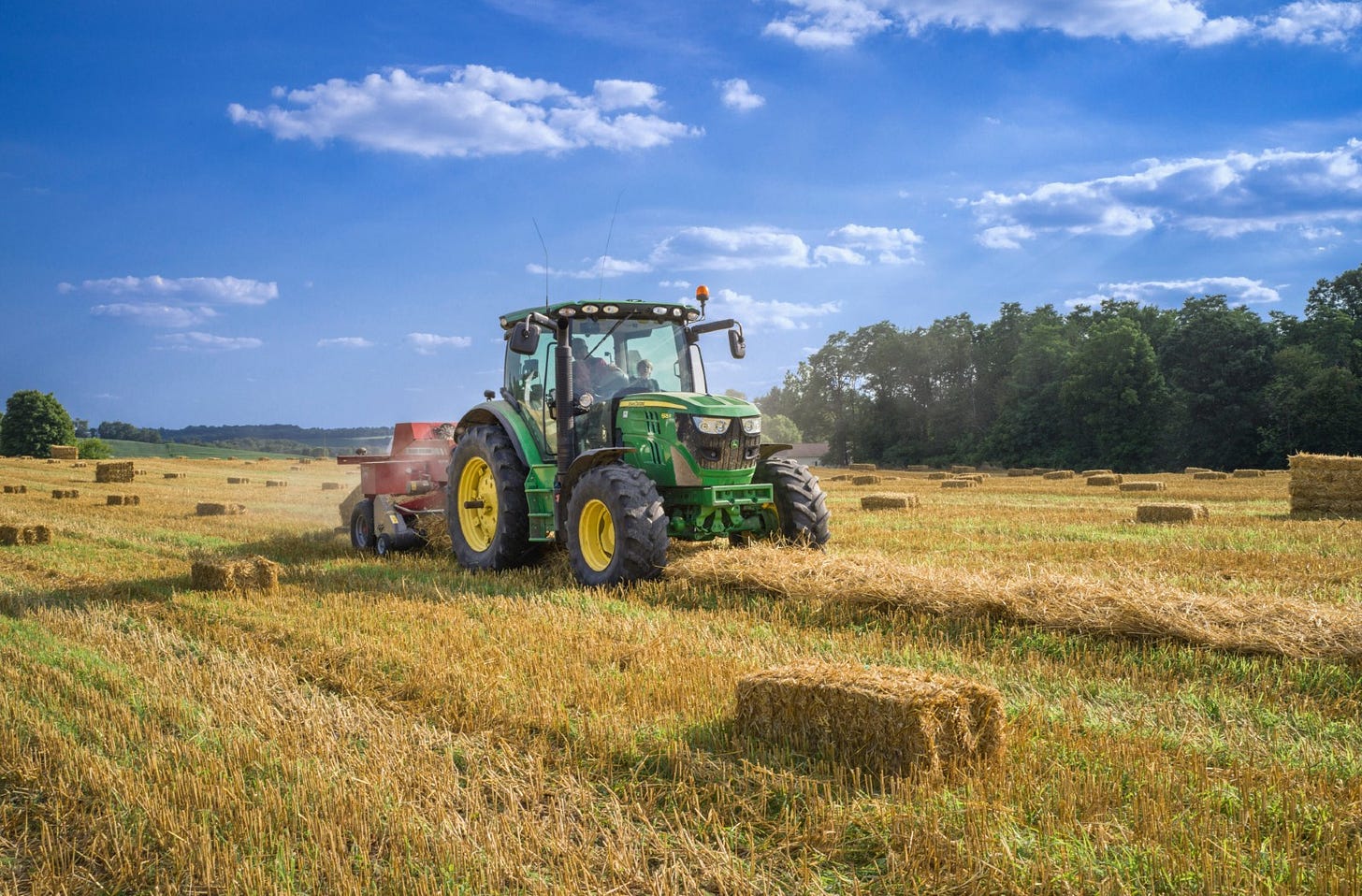
It is worth pausing to count that energy input to rural food production.
A single barrel of oil (42 US gallons or 159 litres) refined and burnt in machines can deliver power equivalent to about 1,700 kW h of work, while a healthy human labourer can perform about 0.6 kW h in one workday. Suppose the farmer uses a barrel of oil across his farm machinery daily, and in the inputs of fertiliser and pesticides. In that case, it is as though he has commandeered 1,500 workers, even if we assume that oil is less efficient at work than pairs of hands.
The human labour that used to perform this work moved to the cities.
If the UN projection for 4 out of 5 people living in large groups with limited capacity to grow their food is correct, what does it say about this virtual rural labour force?
Who is going to the fields?
Urban growth in population size
Before finding an answer, we need to capture another assumption and determine the global population in 2050.
The 20% to doubling in growth of the cities I have lived in over a few decades is not just about this migration to urban areas for a better life, which has increased the proportion of urban dwellers. The overall population has grown too.
Between 1961 and 2024, the global population grew from approximately 3.06 billion to 8.2 billion, with the urban population increasing from about 1.05 billion (34.1%) to 4.6 billion (56.1%), reflecting a 339% rise in urban dwellers.
And don’t be fooled by the populist harangue.
Tech and business leaders like Elon Musk and demographers like Nicholas Eberstadt argue that falling fertility rates, ageing populations, and shrinking workforces in countries like Japan, South Korea, and parts of Europe and China will lead to economic stagnation and social strain. Musk has famously called population decline a “civilizational risk,” urging societies to encourage higher birth rates.
It is true that fertility rates are falling almost everywhere, including in countries that have historically driven population growth. The global fertility rate (the average number of children per woman) has dropped from over 5 in the 1960s to around 2.3 in 2024, and it is projected to fall below replacement level (2.1) by mid-century.
Many major economies, including Japan, South Korea, China, Italy, and Germany, already face population decline or stagnation, with rapidly ageing populations and shrinking workforces.
However, because of the baked-in demographics from historical birth rates, the global population is still increasing by roughly 8,000 people per hour.
So what will the population be in 2050?
Again the UN tells us this figure will be 9.7 billion.
Africa and Asia already has large numbers of youngsters ready to reproduce themselves. All that needs to happen is for these people to remain fed sufficiently to survive and reproduce. The likelihood of this is high given that enough food is grown globally and there are enough fossil fuel inputs available for this to continue for a decade or two longer.
Given the urban growth trend, by 2050 there will be 6.8 billion people in towns and cities fed largely by the efforts of 2.9 billion living in rural areas. This rural population will be 500 million fewer than the current rural population.
The United Nations' World Urbanization Prospects estimates that the global urban population will rise from 4.6 billion in 2024 to approximately 6.7 billion in 2050, meaning that nearly 70% of the world's projected 9.7 billion people will live in cities. This represents a significant increase of 2.1 billion urban dwellers, or a 45.7% growth in urban population over just 26 years.
Just think about that.
More than double the number of people living in cities in 1961 will be added to the urban population by 2050.
Cities must absorb millions of new residents everywhere, requiring massive investment in housing, infrastructure, transport, water, energy, waste management, and social services.
Urbanisation remains one of the defining forces shaping the 21st century.
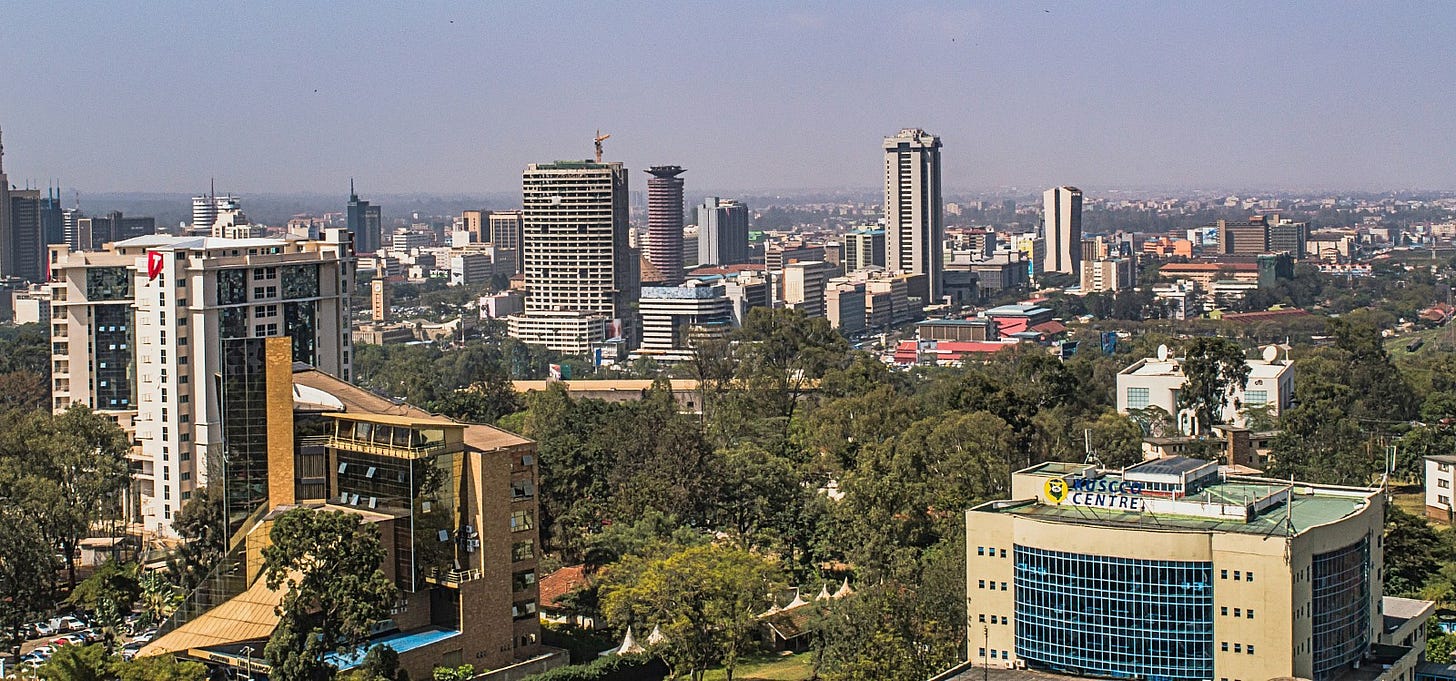
What about the rural community in 2050?
While the total global population is projected to rise, this growth is almost entirely urban.
According to the United Nations, the rural population peaked around 2022–2024 at approximately 3.6 billion and is expected to decline to around 3.0 billion by mid-century. This marks a 16.7% decrease and reflects the historic demographic transition…
the rural-to-urban migration already described remains strong, especially in regions like sub-Saharan Africa and South Asia.
rural fertility rates are falling, though they remain higher than in urban areas
rural areas are ageing rapidly, especially in Eastern Europe and East Asia, and even depopulating due to both migration and low birth rates.
As rural areas lose population, many face labour shortages, ageing demographics, school closures, and economic decline. Meanwhile, the urban burden grows because cities must accommodate not only their native growth but also the steady influx of people from the countryside.
Governments are increasingly challenged to balance investment between sustaining rural communities and expanding urban infrastructure. In a sense, the rural world is becoming numerically and politically smaller, while still playing a critical role in food production, biodiversity, and cultural heritage.
This smaller rural community will need to grow 60% more food than in 2020, with the prospect of a dwindling virtual army of labourers provided by the power of fossil fuels.
The critical assumption in the population projections and the graph of where these people will live is that the energy subsidy to food production will continue and increase by over a quarter in a generation, or roughly 2% per annum.

What if the energy subsidy fails?
It is hard to quantify exactly how much external energy it takes to put food on a person's plate in New York or Mumbai, but here are some recent approximations from the US.
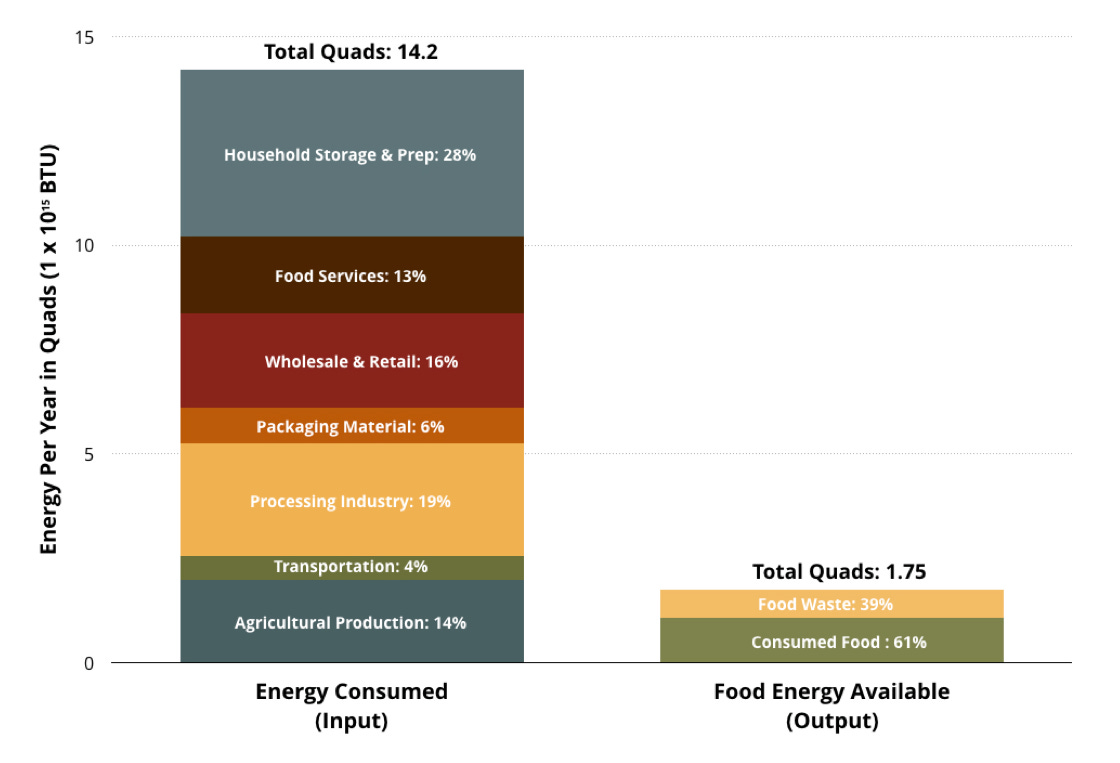
Even if agricultural production is efficient, the food supply system isn’t.
And this is just for energy; we could run similar numbers for resources and nutrients.
At these ratios, the energy subsidy cannot fail. If it does, millions will starve, most of them in cities and towns aggregated from the consequences of urban growth. The historical famines that predominantly affected rural areas due to drought and widespread crop failures will march into the cities.
Future of the energy subsidy.
The reality is that the current forms of energy the farmer uses will not persist beyond 2050. Fossil fuels will either be phased out to reduce greenhouse gas emissions or become too expensive to extract and use.
This will not be sudden for a couple of reasons.
Internal combustion engines power the machinery on farms. Replacing these machines with electrical-powered options will take more work and resources than are currently available. Neither will replacing or retrofitting all road transport vehicles be easy. The ships that take the food worldwide will be especially tough to convert, probably to gas as an interim fuel or directly to hydrogen—the wind is even a possibility.
The challenge is that alternatives still need to be at scale. And some can never be because limited mineral resources are available to manufacture them.
Feeding cities depends on invisible, energy-hungry industries that convert fossil fuels into fertiliser. The production of nitrogen fertilisers relies heavily on natural gas, not just as an energy source, but as a raw material. These inputs are essential to maintaining high yields; without them, farmers face declining productivity and widening yield gaps. In a world dependent on an abundant urban food supply, this energy subsidy is unlikely to disappear anytime soon.
Of all the energy dependencies in the food system, synthetic fertilisers may be the hardest to relinquish.
over 50% of the nitrogen in the average human body today originates from ammonia produced via the Haber-Bosch process.
Energy subsidies will only continue if an alternative energy source comes online. Even then, there are limits to the supplies of raw materials to retrofit or replace all the existing farm machinery and infrastructure.
In short, the future of the energy subsidy to agriculture is perilous.
One future outcome is that the system fails, there is a collapse and a period of chaos.
A better option is this one…
People will move back to the land and reverse urban growth.
As the energy subsidy underpinning intensive agriculture declines, the system will be forced to change.
The industrial-scale food production system we built on cheap fossil fuels, synthetic inputs, and extended supply chains will give way to more local, labour-intensive, and ecologically grounded methods.
Farming will become more closed-loop and regenerative, drawing on soils' natural fertility, the work of people and animals, and biological processes rather than external energy inputs.
Even in cities, more people will be involved in growing food on rooftops, in community gardens, and through small-scale urban agriculture. The shape of the food system will shift from linear and extractive to circular and adaptive, echoing older models where farms produced a net energy gain, not a hidden deficit.
This transition will be difficult, but it’s not impossible. Indeed, it holds potential.
If adaptation fails, the alternative is a systemic unravelling, where food insecurity grows, rural systems collapse, and urban life becomes increasingly fragile.
Whether we navigate this shift with foresight or fall into crisis may depend on how quickly we recognise the true cost of energy-intensive food and how creatively we reimagine its future.
Suppose the energy supply didn’t fail but was gradually transitioned into a much lower per capita use. The transition buys time for people to adjust and for the new production systems to appear and replace the energy input-output approach we have today.
People would return to the land, and more people would grow a proportion of their food.
Here is how we know.
Most countries with at least 50% of the population living in rural areas consume less than 10 barrels of oil per person per year. All the high per capita energy-consuming countries have urban populations.
A handy bonus of slowing urban growth
Returning agricultural production to a net energy source by involving more human labour in food production has bonuses.
If human cultures were more spread across the landscape, soil health would be more easily gained and less energy-intensive. People would more easily eat, dispose of their waste, and maintain their animals inside the plant communities on which the entire system is based.
Instead, we have disconnected ourselves from productive landscapes, paid to clean up the pollution in cities and feedlots—cities are functionally equivalent to feedlots for people—and then paid to mine, manufacture, transport, and disperse replacement minerals back to the soil.
Here is how Jason Bradford from the Post Carbon Institute explains the luxury of long-distance transport of food to cities and long-distance transport of wastes back to farms.
This is called progress. It would be wise to sort out how to return to land what we take from it and dispense with energy-demanding mining and processing. Returning all human waste to fields is entirely possible and was the method by which Chinese and Japanese farmers persisted for centuries.
Jason Bradford
Urban Growth, Fossil Fuels, and the Mirage of Endless Expansion
The past century of human population and economic growth, powered by fossil fuels, has been nothing short of extraordinary.
No other species has so effectively harnessed external energy to multiply, manufacture, and aggregate in dense urban centres. It has been a fossil-fuelled miracle.
We understand this from ecology. When organisms are flooded with excess resources, they grow. Bacteria, fungi, and even locusts follow the same script. But we also know how the story ends when the resources run out. Growth consumes. And industrial civilisation, in its pursuit of more-making, has burned through the energetic inheritance that made it possible.
So the projection of continued urban expansion, the upward brown and downward orange lines in the graph, is dangerously naive.
A mindful sceptic would challenge such linear extrapolations, no matter how stable the historical trend appears. When the energy subsidy fades, many may be forced to return to the land, not as a lifestyle choice, but as a last resort.
Instead of assuming that urban growth is guaranteed, we should prepare for a different future shaped by managed transition, not unplanned collapse.
Mindful Momentum
A Personal Energy Audit
This week, trace one meal from plate to farm gate. Pick something simple like your morning coffee or lunch sandwich and map its journey.
Where was it grown? How did it reach you? What energy inputs powered each step?
Don't aim for perfection; aim for awareness. The goal isn't to guilt yourself, but to develop systems thinking that questions seemingly simple processes.
Here is another one…
The Linear Trend Challenge
Identify three "inevitable" trends in your community. It might be rising house prices, increasing traffic, or declining local businesses.
Apply some mindful scepticism to the trend.
What energy, resources, or assumptions make these trends possible? What would happen if those foundations shifted?
Spend 15 minutes researching one trend's underlying dependencies. This builds your capacity to question projections that everyone accepts as fact.
Key Points
United Nations data shows urban populations rising from 56% globally in 2024 to an estimated 70% by 2050, with cities expected to absorb over 2 billion additional residents. However, these projections extrapolate from a century of unprecedented energy abundance without adequately considering the systemic dependencies that enabled this migration. The assumption that historical trends will continue indefinitely represents a fundamental failure to account for the finite nature of the energy systems underpinning urban food security.
Modern cities depend entirely on an invisible energy subsidy, transforming rural agricultural output into urban food consumption. Analysis of contemporary food systems reveals that approximately eight units of external energy are required to deliver one unit of food energy to urban populations, rising to fourteen units when food waste is included. This energy-intensive process involves mechanised farming, synthetic fertiliser production, transportation networks, processing facilities, and cold storage systems—all currently dependent on fossil fuels. Urban areas consume up to 80% of global food production while producing virtually none, creating unprecedented dependency on energy-subsidised rural productivity.
Climate policies and resource depletion will inevitably reduce the availability of cheap fossil energy that currently powers agricultural machinery, fertiliser production, and food transportation networks. Synthetic nitrogen fertilisers, which support over 50% of current agricultural yields, require natural gas as fuel and raw material. Without viable large-scale alternatives, declining energy availability will force agricultural systems toward more labour-intensive, locally-focused production methods.
Energy constraints may reverse urbanisation trends, requiring significant population redistribution toward agricultural areas. Countries with high per capita energy consumption consistently show highly urbanised populations, while nations with lower energy use maintain larger rural populations engaged in food production. As energy subsidies decline, maintaining current urban population ratios becomes thermodynamically impossible. The mathematical relationship between energy availability and sustainable population distribution suggests that successful adaptation will require more people returning to direct involvement in food production, fundamentally challenging assumptions about inevitable urban growth and modern economic organisation.
Curiosity Corner
This issue of the newsletter is all about…
The invisible energy costs of feeding urban populations raise questions about whether history's most significant human migration might reverse course within decades.
5 Better Questions from this issue of the newsletter…
What other "inevitable" trends in our society depend on cheap energy that we're assuming will continue forever?
This question is better because it moves beyond just urban growth to develop pattern recognition for spotting hidden energy dependencies across multiple systems.
If our cities are essentially human feedlots requiring constant external inputs, what does that tell us about our definition of progress?
This question is better because it challenges fundamental assumptions about what constitutes advancement rather than simply accepting urban life as inherently superior.
How might the skills and knowledge we consider valuable today become obsolete or insufficient in a lower-energy future?
This question is better because it forces personal reflection on adaptability rather than assuming current expertise will remain relevant indefinitely.
What percentage of your daily life depends on systems you cannot influence, understand, or replace?
This question is better because it builds awareness of personal vulnerability and dependency rather than maintaining illusions of self-sufficiency or control.
Where in your community are people already experimenting with alternatives that mainstream projections ignore?
This question is better because it seeks out emerging solutions and local innovations rather than waiting passively for top-down policy changes or technological fixes.
In the next issue
We're Eating Oil (And Don't Even Know It)
The diesel in your morning toast, the natural gas in your evening rice, and why humanity's most remarkable triumph contains the seeds of its potential downfall.
Next time we’ll unpack how 23.9 trillion daily kilocalories reveal both our species' unprecedented success and our most dangerous dependency.
Plus…
A simple 20-minute exercise that will forever change how you see your refrigerator.



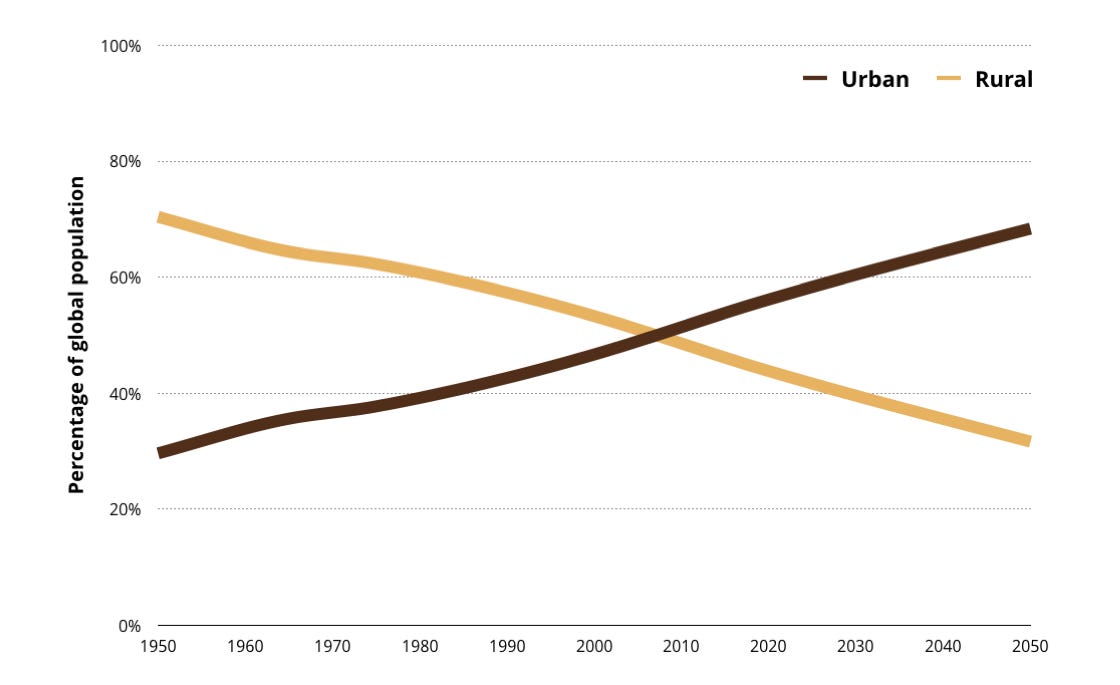
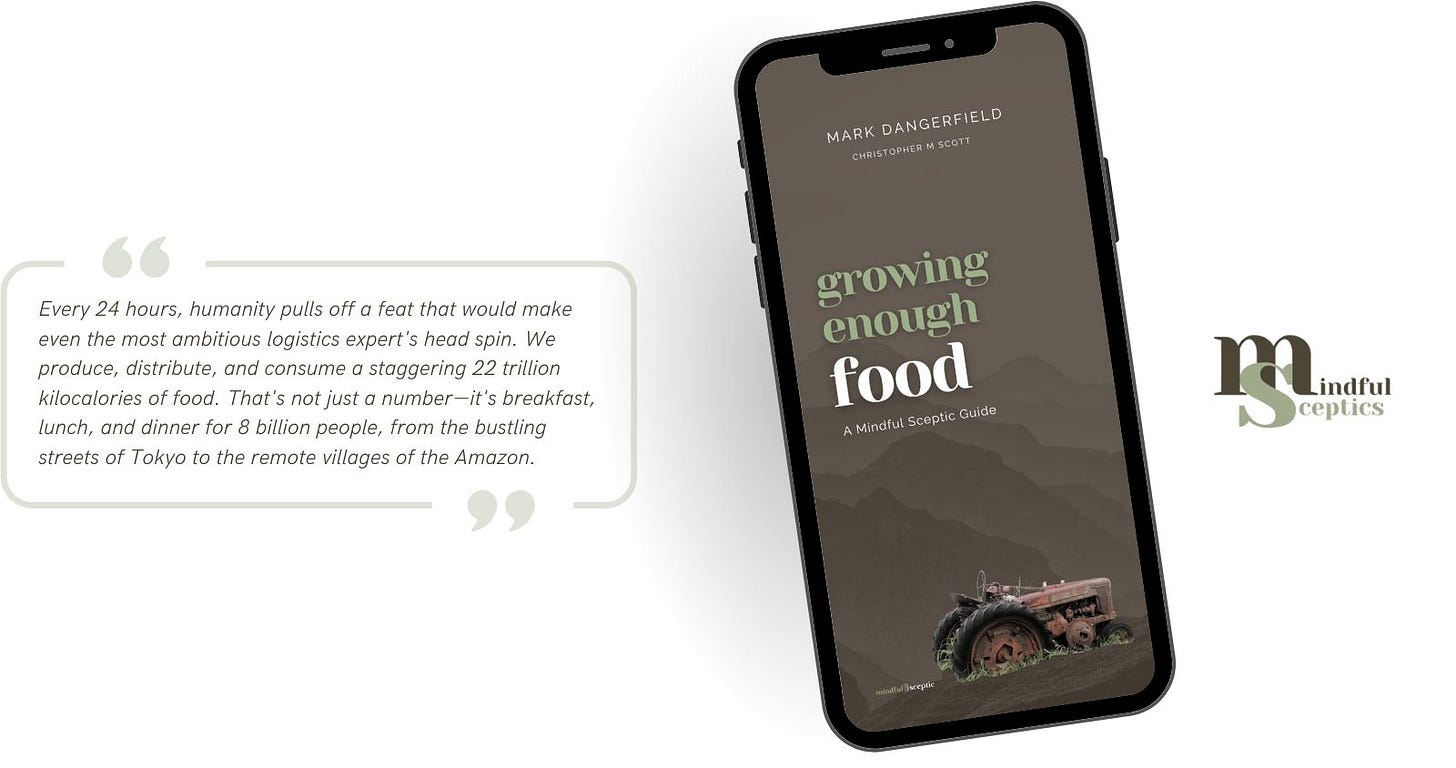

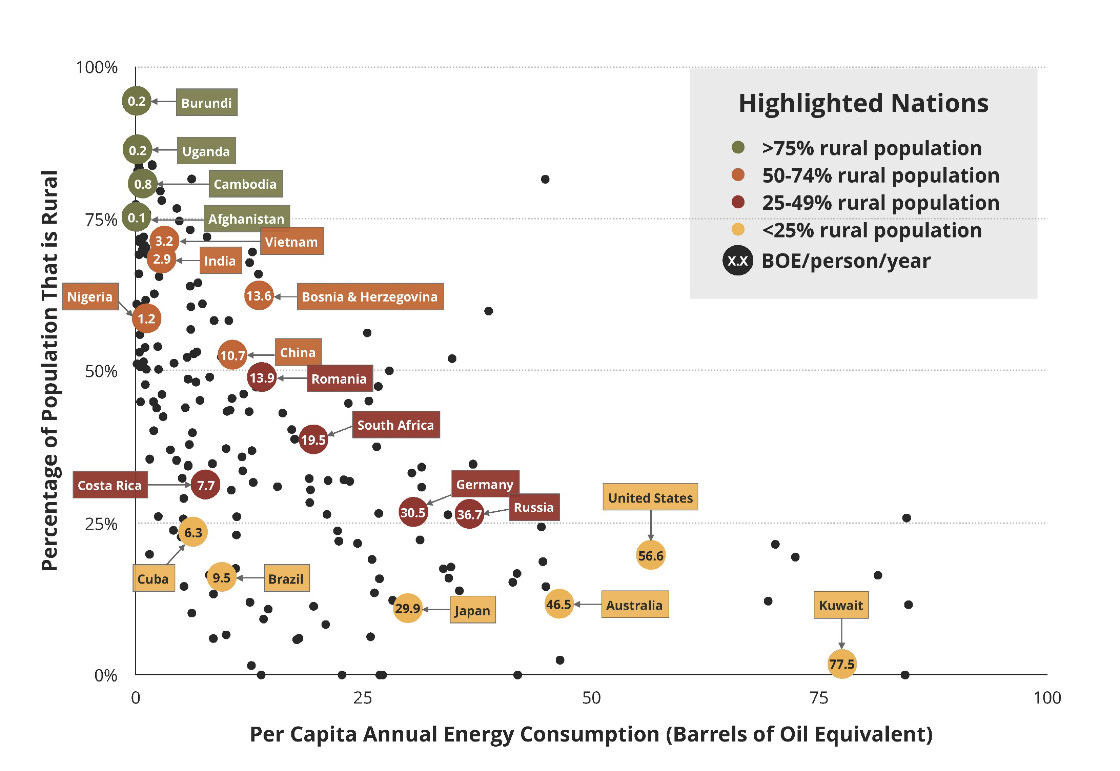
Good, thought provoking, so here are my thoughts:
1. Ammonia. For all my life there has been no progress on nitrogen fixation, but recently there are several lines of work that are promising. In particular, electrochemistry is really moving into industry and there are some good results of N fixation with this technique. If it works we can have small units using locally generated power.
2. Other fertilisers. We are getting much more efficient at not losing K and P to runoff, so cutting the amounts required.
3. Transport should transition to EV quite easily, as heavy trucks have quite a short life. This reduces the energy required by a factor of around 4.
4. Agricultural machinery will get lighter as we move to autonomous vehicles and minimum plough methodologies
5. Solar farms have proved compatible with livestock and to some extent arable, so farms can generate power for themselves and for export to cities.
6. I see no mechanism which translates a breakdown in the current system into a flow reversal. If anything increased demand for food makes agriculture more profitable, so increasing the value of productive land relative to converting it to housing. Society can handle a transition to high cost food so long as there time is long enough.
Thanks for this post. Some great quotes--I restacked it twice and could have a couple more times.
I like the term stratification. Cities are built, and their allure sold, on multiple layers of dependence. You can live in the city, as I did for a good part of my life, and never see much of what sustains you. Your water, food, sewer, heat, electric power etc,....is all trucked, pumped, cabled etc,... to you. This complete disconnect from the natural world, which supports all of our needs, makes possible our continued reliance on high energy consumption. If 80-85% of North Americans live in urban areas, including our policy makers--they just don't have any relationship to or visibility of their life support systems.
I am impressed you are suggesting positive directions for our high-energy Western societies to go in. I'm afraid I'm not as hopeful.